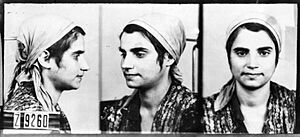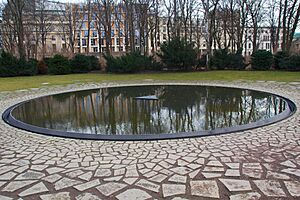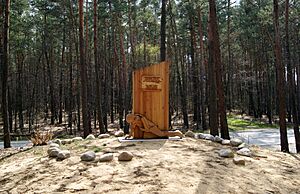Romani Holocaust facts for kids
Quick facts for kids Romani Holocaust |
|
|---|---|
| Part of World War II | |
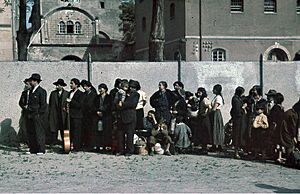
European Roma and Sinti in Asperg, Nazi Germany, are rounded up for deportation by Nazi German authorities on 22 May 1940.
|
|
| Location | Nazi Germany and its occupied territories |
| Date | 1939–1945 |
| Target | European Roma and Sinti |
|
Attack type
|
Genocide, ethnic cleansing, mass murder |
| Deaths | At least 150,000. Other estimates give figures such as 500,000 800,000 or even as high as 1.5 million. |
| Perpetrators | Nazi Germany and its allies |
| Motive | Antiziganism, Germanisation, Pan-Germanism, Racism, Nazi racial policy |
The Romani Holocaust, also known as the Romani genocide, was a terrible plan by Nazi Germany and its helpers during World War II. They wanted to get rid of the Roma and Sinti people living in Europe. This was part of a larger event called The Holocaust, where millions of people were killed because of who they were.
Under Adolf Hitler, a new rule was made in 1935. It said that Romani people were "enemies of the state" because of their race. This put them in the same group as Jewish people. So, the Roma faced a similar terrible fate as the Jews during the Holocaust.
Historians believe that between 250,000 and 500,000 Romani and Sinti people were killed. This was a huge number, making up 25% to over 50% of all Roma in Europe at that time. Some later studies even suggest the death toll could have been as high as 1.5 million out of 2 million Roma.
In 1982, West Germany officially said that Nazi Germany had committed genocide against the Romani people. Later, in 2011, Poland made August 2nd a special day to remember the Romani genocide.
Inside Nazi Germany, the Roma were first treated badly, then killed. This was especially true for Roma who lived in one place. In December 1942, a Nazi leader named Heinrich Himmler ordered all Roma to be sent away from Germany. Most were sent to a special camp called the Gypsy concentration camp at Auschwitz-Birkenau. About 21,000 of the 23,000 Roma and Sinti sent there did not survive. In other parts of Europe that Germany had taken over, Roma who were seen as "wanderers" were also killed. These killings were often done by the German military and police.
Remembering the Romani Holocaust
After the Holocaust, the German government paid money to Jewish survivors. However, they did not pay money to Romani survivors. Some officials claimed that Roma were treated badly not because of their race, but because they were seen as "antisocial."
Ways People Remember
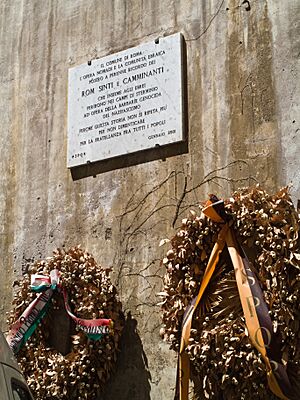
The first memorial for Romani Holocaust victims was built in 1956 in Poland. Since 1996, a "Gypsy Caravan Memorial" has traveled to different remembrance sites in Poland. It brings together Romani people and others to remember the Porajmos (the Romani word for the Holocaust).
Some museums also have parts of their exhibits about this history. These include the Museum of Romani Culture in the Czech Republic and the Ethnographic Museum in Tarnów, Poland.
In 2007, President Traian Băsescu of Romania said sorry for his country's part in the Porajmos. He was the first Romanian leader to do so. He said that the Porajmos should be taught in schools. He even spoke some of his apology in the Romani language.
On January 27, 2011, Zoni Weisz became the first Roma person to be a special guest at Germany's official Holocaust Memorial Day ceremony. Weisz, who was born in the Netherlands, escaped death during a Nazi roundup. At the ceremony, they also remembered other Roma victims, like the Sinto boxer Johann Trollmann.
In July 2011, the Polish Parliament officially made August 2nd a day to remember the genocide.
In 2012, a special music piece called Requiem for Auschwitz was performed in Amsterdam. It was written by Roger Moreno Rathgeb, a Sinto composer. The music was played by The Roma and Sinti Philharmoniker, an orchestra of Roma and Sinto musicians. This requiem was written for all victims of Auschwitz and Nazi terror.
On October 24, 2012, the Memorial to the Sinti and Roma Victims of National Socialism was opened in Berlin. Since 2010, a group called ternYpe – International Roma Youth Network has organized a remembrance week called "Dikh he na bister" (meaning "look and don't forget"). This event happens around August 2nd in Kraków and Auschwitz-Birkenau. In 2014, over 1000 young people from 25 countries attended the largest youth ceremony ever.
Images for kids
-
German troops gather Romani people in Asperg, Germany, in May 1940
See also
- Roma Holocaust Memorial Day
- Gypsy family camp (Auschwitz)
- Romani people


